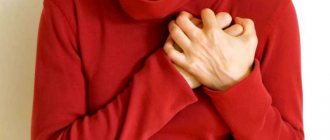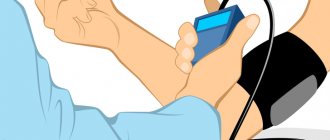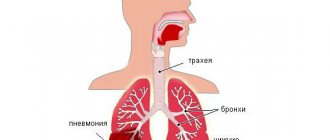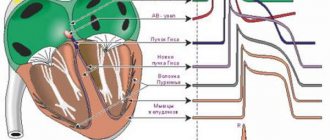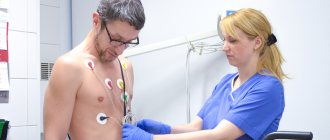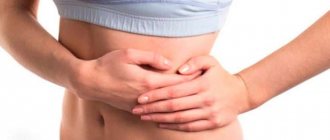Pressing pain in the heart area is a nonspecific symptom of many possible diseases and pathological conditions.
It does not occur in isolation; it occurs together with other deviations in well-being. They usually coexist with various types of arrhythmias, respiratory and gas exchange disorders, motor dysfunctions, and others.
Relieving the symptom itself is not of great importance; treatment of the underlying condition is required under the supervision of a competent specialist in cardiology, and in some cases, specialized surgery.
The manifestation can be relieved with standard or narcotic analgesics. The choice is made based on the severity of the patient’s general condition. The development of shock is possible in some diseases, which complicates treatment. In such a situation, eliminating the sign plays a key role.
Causes of pressing sensations
The factors for the development of pathological symptoms are different, there are many of them. They can be either primary or secondary.
Myocardial infarction
Acute, avalanche-like necrosis of a section of the heart muscle. Develops as a result of long-term arterial hypertension, coronary insufficiency of an unstable progressive nature. Occurs mainly in older patients.
Accompanied by a group of nonspecific manifestations:
- Intense excruciating pain in the chest, as if the heart was pinched. Discomfort radiates to the left arm, shoulder blade, abdomen in the stomach area, and can radiate to the back. A heart attack can be determined by the strength of the unpleasant sensation. In the event of an emergency, there is a risk of developing shock.
- Dyspnea. Inability to get air, dissatisfaction with the process. The result of decreased gas exchange. Occurs in a state of complete rest.
- Impaired consciousness. It is difficult for the patient to recover from fainting. The phenomenon is preceded by clouded thinking and inadequate reactions to external stimuli.
- Complete peace, emotional and mental inhibition or, on the contrary, excitement. Both options are equally dangerous, the second does not indicate the normal state of affairs. It all depends on the type of nervous system of the patient.
- Cyanosis of the nasolabial triangle or bluish discoloration of the area around the mouth.
- Paleness of the skin.
- Increased, excessive sweating, hyperhidrosis.
- Disturbance of normal heart rhythm. According to the type of tachycardia or the reverse phenomenon of bradycardia.
Treatment in hospital, urgent. Radical (surgical) techniques are impossible; it is necessary to stabilize the patient’s condition and accelerate tissue scarring. In the future, lifelong maintenance therapy is indicated.
Nagging pain in the heart area: etiology, nature, treatment
Almost every person over 50 has experienced nagging pain in the heart area. They are caused by pathology of the heart vessels. Usually their lumen is “clogged” with cholesterol plaque. Without treatment, a tragic outcome is possible – myocardial infarction. Therefore, it is important to listen to the body and ask yourself why these pains appeared and what to do next.
In addition to stress, psycho-emotional stress can be a provoking factor. Cardiologists and psychologists identify the most common trigger situations:
Treatment of neuroses and VSD
For neuroses, psychotherapy and medications (antidepressants, nootropics, sedatives - depending on the disease) are effective.
As for VSD, the causes of this pathology are still not fully understood, so treatment is symptomatic (drugs to lower or increase blood pressure, eliminate rhythm disorders, relieve psychological manifestations).
It has also been established that a correct lifestyle helps to minimize and even eliminate the signs of VSD. To do this, toughen up, lead an active lifestyle, give up bad habits, get plenty of rest, and strictly follow your daily routine.
As for VSD, the causes of this pathology are still not fully understood, so treatment is symptomatic (drugs to lower or increase blood pressure, eliminate rhythm disorders, relieve psychological manifestations).
Thromboembolism
The essence of the pathological process is blockage of the pulmonary artery (complete or partial).
In the first case, death occurs without preliminary manifestations within a couple of minutes, without the possibility of returning the patient. The second option can be eliminated. The intensity of manifestations is high.
Sample list:
- Pressing pain in the heart. Extremely intense, like a heart attack. Lasts about 30 minutes, maybe more. Then comes a period of imaginary well-being, when the feeling fades away. At this moment, the destruction of cardiac structures accelerates, death becomes an almost inevitable consequence.
- Suffocation. The patient has difficulty breathing; inhalation feels like swallowing air.
- Impaired consciousness up to the onset of coma.
- Tachycardia.
- Changes in complexion (pallor of the skin).
- Dilation or constriction of the pupils.
- A drop in blood pressure, possibly to critical levels.
- Cough, with a developed process with traces of blood in the discharge.
Therapy in a hospital. Unconscious patients are sent to intensive care. Take urgent action to relieve the condition: usually conservative (medicinal) methods are ineffective.
Myocarditis
Inflammation of the muscle layer of the organ. In 80% of cases it is of infectious origin.
It is provoked by viruses, bacteria (pyogenic flora), less often by fungi. An autoimmune process is possible.
The intensity of the signs is the same in both cases. The latter are determined by a chronic, long-term course. The former are characterized by acuteness and high speed of development.
Symptoms:
- Heartbreaking. It feels like the pressure in your chest has increased dramatically. The discomfort is significant, but less than with a heart attack.
- Lack of air. Shortness of breath is present in a state of complete rest, physical activity is impossible. The patient is in a forced supine position. Intensification of mechanical activity leads to cardiac arrest.
- Tachycardia. A pulse of more than 100 beats per minute is constant, without interruption, which significantly affects the quality of life and does not allow normal rest even at night.
- A common but optional symptom is an increase in body temperature. For infectious conditions - from 38 degrees Celsius. Autoimmune are characterized by an indicator of about 37 or slightly more.
Treatment in a hospital. Antibiotics, antiviral or fungicidal agents are used. Also cardioprotectors, if necessary, diuretics and corticosteroids.
The duration of therapy varies from 4 to 12 days. Dynamic, regular monitoring by a doctor is indicated for six months or more.
False angina
It is a type of neurogenic pathology. Strictly speaking, it has nothing to do with heart problems.
This is a type of vegetative-vascular dystonia. It is also not dangerous, but may be mistaken for an emergency.
Accompanied by the following symptoms:
- Heaviness in the heart. The pain is intense, pressing, in the middle of the chest. Lasts about 15 minutes. Occur sporadically. Several times during the day. If you look closely, you can find a connection between weather conditions, habits, current emotional state and manifestation. Such a correlation is not typical for true cardiac diseases.
- Dyspnea. The feeling of lack of air is rather psychosomatic in nature. Occurs in patients with a special nervous system.
There are no other symptoms. This allows one to suspect false angina. Objective studies (ECHO and ECG) put an end to the issue.
Treatment under the supervision of a neurologist. Sedatives, tranquilizers, and cerebrovascular drugs are used. A diet is prescribed.
Mitral valve defects
Such as prolapse (retraction of the valves into the chamber cavity) or stenosis (up to complete fusion).
The patient's sensations are as follows:
- Aching pain in the heart. Unlike other conditions, defects of this kind do not develop right away. This is a long process. Accordingly, the pain syndrome continues for months, if not years. A paroxysmal course is typical, the duration of each episode is from 10 to 30 minutes or more. There may be more than one per day.
- Feeling of pressure in the throat, lump, feeling of a foreign body.
- Headache, vertigo.
- Weakness, drowsiness. This is a consequence of incipient organic abnormalities on the part of cardiac structures and malnutrition of cerebral tissues.
- There may be a slight increase in body temperature.
The treatment is strictly surgical, but at the initial stage, few people will recommend, as they say, going under the knife. Competent doctors delay this moment until the last minute, resorting only in an emergency or if there is no other way out.
After surgery, maintenance therapy using medications of a number of groups is indicated. The final treatment regimen depends on how extensive the changes are in the anatomical structure of the heart and surrounding tissues.
Cardialgia
The generalized name of the symptomatic complex, the basis of which is chest pain.
The duration of episodes of discomfort is minimal, but they are repeated up to 3-6 times a day, for a long time.
Periods of spontaneous remission are possible, when symptoms are completely absent for a couple of months or even years. Then a relapse and so on in a circle.
As a rule, there are no objective reasons for discomfort, which makes it impossible to identify the origin and specify the etiological (root cause) factor. Then they talk about the idiopathic form.
Hypertonic disease
Especially long lasting ones. It is accompanied not only and not so much by pain in the chest, but by squeezing sensations in the occipital region, the crown of the head.
Fainting, syncope, shortness of breath, problems with speech, concentration and other nervous functions (numbness of the hands, fingertips) are also possible. The treatment is long-term. Acute conditions, such as a hypertensive crisis, are treated in a hospital.
If the heart is compressed, there may be cardiac abnormalities. They are united by one fact: unpleasant sensations rarely last more than 40 minutes even with a heart attack; a typical paroxysmal course is typical.
Features of treatment, complications
If there are unpleasant sensations in the chest, a “heaviness has fallen” on the heart, at home you should:
- call an ambulance;
- calm the person down, put him or her in a comfortable position;
- provide access to fresh air;
- loosen tight clothing;
- if the attack is not the first time, and there are medications prescribed by the doctor, you need to take them (for example, Nitroglycerin, Corvalol)
If it is angina pectoris, the attack is stopped before the doctors arrive. In case of more serious pathology, hospitalization is necessary.
When do you need a doctor?
It is imperative to consult a doctor if you have the following symptoms:
- burning sensation in the chest, increasing in intensity;
- a sharp drop in blood pressure (below 80 mm Hg) or increase (more than 180 mm Hg);
- fainting;
- cough with blood;
- no response to Nitroglycerin.
This requires emergency medical care, and you must remember that each subsequent attack can be fatal. Each of us is primarily responsible for our own life and health.
Medicines
Drug therapy is divided into symptomatic and pathogenetic. Symptoms are relieved with coronary dilating drugs: Validol, Nitroglycerin. Blood flow to the myocardium relieves the feeling of heaviness. Pathogenetic includes:
- anticoagulants: Clexane, Heparin, Flenox;
- antiplatelet agents: Clopidogrel, Aspirin;
- statins: Rosuvastatin, Simvastatin;
- antihypertensive: Amlodipine, Enap, Valsartan;
- beta blockers: Metoprolol, Nebivanol, Atenolol;
- Nitrates: Nitrong, Dikor-Long.
If conservative therapy is ineffective, surgical methods are used:
- stenting – installation of a metal structure in the area of narrowing of the vessel;
- coronary artery bypass grafting – creation of additional blood flow bypassing the stenosis;
- installation of a pacemaker - an electronic device that analyzes the heart rhythm, its conductivity and corrects them with electrical impulses;
- treatment of heart defects with occluders - an umbrella patch that covers a defect in the chambers of the heart
The method of therapy depends on the etiology.
Psychosomatic factors
They are not objective in nature, that is, there are no actual pathologies leading to discomfort. This is a far-fetched problem for the most part.
An approximate list of possible reasons is as follows:
- Hypochondria. Mental disorder. In recent years, scientists have been inclined to think that this is rather a personality quality. Increased anxiety regarding your health. Accompanied by searches for non-existent diseases, of course unsuccessful. Heaviness and pain are false and arise as a result of focusing attention on the anatomical area.
- Stressful situations. It's a double-edged sword. It is possible that the discomfort is the result of prolonged stress, but it is also possible that overload led to the development of cardiac problems.
- Phobic states. They provoke attacks of cardialgia, as well as episodes of nausea, excessive sweating, and confusion. Particularly impressionable people may faint. It is not normal. You need to work with a psychotherapist (not to be confused with “same-rooted” specialists).
- Chronic fatigue syndrome. Contrary to what you might think, this is by no means a newfangled “bourgeois” disease. The wave is a real problem. Develops as a result of asthenia of the nervous system. Hence, possible organic pathologies due to impaired regulation of vascular tone and heart rate.
- Post-traumatic stress disorder. It occurs in patients who have suffered violence, military personnel who have been in real conflicts, also in people after an accident, etc. Persons with suspected psychosomatics as a source of pain should not be dismissed under any circumstances. A thorough diagnosis is required. Perhaps the patient really feels discomfort associated with organic pathologies.
Extracardiac moments
There are several conditions that can mimic heart pain.
Lung tumor
Usually left, but not necessarily. In this localization, malignant neoplasias differing in histological properties (sarcomas and others) are likely to occur.
Additional symptoms:
- Intense shortness of breath. The patient suffers from dissatisfaction with the natural process. Gradually, the phenomenon leads to asphyxia and death.
- Hemoptysis. Accompanies even the initial stages.
- Sudden loss of body weight.
- Cephalgia (headache).
- Prolonged episodes of hyperthermia. The thermometer is at levels from 37 to 37.7. Rarely higher.
- Chest pain of a diffuse nature, not only in the heart area.
- Nausea, vomiting.
- General weakness. In later stages, up to the inability to get out of bed. In chronic patients, apathy sets in, which aggravates the situation.
Treatment is surgical. Using chemotherapy and radiation techniques.
Pneumoconiosis
Organic defect in the lungs. Associated with gradual epithelization and tissue calcification.
Has no specific manifestations. The main sign of pneumosclerosis is pressure in the heart area. In fact, the cardiac structures are not involved, but it is a matter of time.
Treatment is basically impossible.
Tuberculosis
Damage to the pulmonary structures by mycobacterium or Koch's bacillus, as it is otherwise called.
Accompanied by a strong prolonged cough, sweating at night, increased body temperature on a long-term basis (sometimes for years), changes in facial features, and hemoptysis.
Treatment is effective in the early stages. Fluoroquinolones (a special group of synthetic antibiotics) are used. Other activities are aimed at supporting the respiratory and cardiovascular systems.
Acute and chronic pneumonia
Pneumonia. The pain is nonspecific, localized in the sternum, and has a pressing, pressing character. They accompany the person most of the time. They intensify with physical activity and intensification of breathing.
Treatment in a hospital with the use of anti-inflammatory drugs, antibiotics, corticosteroids, fungicides and others as indicated. Each case is unique, therefore the average scheme has no practical significance.
Intercostal neuralgia
Inflammation of the corresponding tissues. The pain is strong and squeezing, but there are no other symptoms. Treatment is not always carried out. NSAIDs are used.
The reasons why the heart presses may not be of cardiac origin. Doctors know this, therefore, after excluding pathologies in their profile, they send the person to other specialists.
In the absence of evidence for organic conditions, idiopathic discomfort is diagnosed. It is treated as needed, this is a symptomatic measure.
Treatment methods depending on the type of pathology
Heart pain caused by an attack of angina due to coronary heart disease usually goes away within a few minutes after using nitroglycerin in the form of a spray or capsule.
If cardialgia does not improve, despite nitro drugs, doctors talk about “unstable angina.” This may indicate acute myocardial infarction. A heart attack is a medical emergency. The victim should already be treated on the way to the hospital.
Warning signs indicating unstable angina or heart attack include:
- Heart pain and shortness of breath during physical activity occur for the first time.
- The pain becomes worse or more frequent.
- Complaints are different from usual (eg, in a different place, stronger, longer).
- Chest pain occurs with less stress than usual.
- Cardialgia does not disappear after rest.
- Symptoms do not improve with nitroglycerin use.
Causal treatment for cardialgia depends on the underlying condition. Long-term treatment for heart pain caused by coronary artery disease ranges from lifestyle changes to medications and surgery.
Other heart diseases that cause heart pain are bacterial endocarditis. Inflammation of the mucous membrane of the heart is recommended to be treated with antibiotics.
How to recognize heart pain or not?
There are several specific signs of cardiac sensations:
- They do not depend on body position. Others intensify when changing posture or movement. This indicates pulmonary problems, but more often intercostal neuralgia.
- There is no connection with breathing either. Other pains intensify when inhaling.
- The duration of cardiac sensations is no more than 40 minutes or an hour, even in the most difficult cases. Episodes may be frequent.
- The intensity is high only with a heart attack and acute angina. The use of narcotic analgesics is practiced.
A nonspecific sign of heart pain is the possibility of relief with Nitroglycerin. Many problems with the muscular organ are eliminated this way. Others don't.
What can you do at home?
Almost nothing. If the cause of the heaviness in the heart is not known, there is a chance that things will only get worse. You need to call an ambulance and wait for the doctors to arrive.
Before the brigade arrives, it is recommended to take a horizontal position. If you experience severe shortness of breath, sit down and hang your arms and legs so as not to interfere with normal blood flow. Place a cushion made from scrap materials under your back.
You can take a tablet of a mild sedative based on herbal ingredients. Motherwort or Valerian are ideal (just not alcohol tincture). If you are sure of cardiac origin, use Nitroglycerin. It relieves pain.
There is no need to breathe artificially. Vagal techniques will not help. Then all that remains is to wait.
What needs to be examined?
Diagnosis is carried out under the supervision of a cardiologist. If there are no problems in his area, the patient is referred to other specialists.
Approximate list of events:
- Oral questioning of the patient regarding complaints, as well as collection of anamnestic data.
- Measurement of blood pressure (high or low, nonspecific sign), heart rate.
- Auscultation (listening to heart sounds).
- Daily monitoring using an automatic Holter device. Records the same indicators for 24 hours.
- Electrocardiography. Assessment of the functional activity of cardiac structures. Shows the slightest rhythmic disturbances.
- Echocardiography. Used to detect organic defects.
Other techniques that are not directly related to cardiology:
- Ultrasound of the abdominal cavity.
- Chest X-ray.
- Blood test (general, biochemical), also sputum for flora.
- MRI of pulmonary structures.
- Study of neurological, psychiatric status (in the absence of data for other conditions).
- It is possible to prescribe EFI and stress tests. At the discretion of the treating specialists.
Diagnostics
During the examination, patients are recommended to:
- go through the stage of collecting anamnesis, physical examination;
- pass OAC, OAM, biochemistry;
- ECG;
- X-ray examination with a general X-ray of the chest, CT, MSCT, mammography:
When it comes to the heart, they usually add:
- cardio-ultrasound, Holter;
- load tests;
- MRI of the spine, electroneuromyography;
- FGDS.
Consultations with specialized specialists who can help differentiate breast pathology from heart disease are required.
